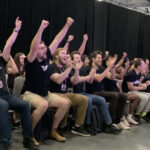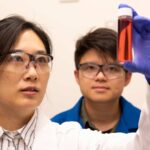
Discovery, innovation highlight 2015

At the Fulton Schools of Engineering, 2015 was filled with excellence, innovation and discovery.
From new technologies to new research centers and efforts, the Fulton Schools showed the excellence of its faculty, students and staff in a variety of ways.
Following are just a few of the many notable and noteworthy stories from the year. For more, visit Full Circle.
ASU taking reins of new national geotechnical engineering research center
ASU will lead a new national geotechnical engineering research center aimed at developing ways to make our built environment more sustainable.
The consortium of university, industry and government partners has been awarded $18.5 million to establish the Center for Bio-mediated and Bio-inspired Geotechnics (CBBG) to expand the emerging field of biogeotechnical engineering.

This schematic illustrates the novel nano sheet with three parallel segments created by the researchers, each supporting laser action in one of three elementary colors. The device is capable of lasing in any visible color, completely tunable from red, green to blue, or any color in between. When the total field is collected, a white color emerges.
Popular Science picks Fulton Schools innovation as a top world-changing technology
Every December for the past 28 years, the editors of Popular Science have sought out products and technologies poised to change our world. They review thousands of new products and innovations to choose the top 100 in 10 categories.
This year Arizona State University electrical engineering professor Cun-Zheng Ning and his research group have been awarded a 2015 Popular Science Best of What’s New Award in the engineering category for their breakthrough in demonstrating the world’s first white laser.
Rice, ASU, Yale, UTEP win coveted engineering research center
ASU and a consortium of industry, university and government partners have been awarded $18.5 million to establish one of the National Science Foundation’s (NSF) prestigious Engineering Research Centers to develop compact, mobile, off-grid water-treatment systems that can provide clean water to millions of people who lack it and make U.S. energy production more sustainable and cost effective.
ASU researchers have been allocated $3.2 million for their role in the center.
Countering social influence and persuasion of extremist groups
Social media has become a vital channel for terrorist groups to share news and seduce new members. The recent, notable successes of ISIS in the United States and Europe have demonstrated that terror groups can successfully use this approach to further their agenda of violence. While it gets less attention, social media is equally important for groups that are sharing and communicating information to counter extremist discourse.
The problem is, how can those looking to counter the violent ideology of groups like ISIS analyze all the conversations to determine what is a significant danger? How can groups countering violent extremism leverage social media to limit the diffusion of extremist ideology?
ASU will lead new research aimed at helping to solve this puzzle. The university has been selected to receive a highly competitive Minerva grant to gain a better understanding of what types of information “go viral” and under what circumstances.

The Local Motors-ASU team of student and faculty researchers will be focused on designing, simulating and fabricating a set of test structures and test systems to increase the inter-laminar strength of 3D-printed automotive parts. Professor Keng Hsu overseeing students working on the Local Motors eProject. Photo courtesy of Local Motors
Local Motors, ASU partner on high-tech materials R&D for 3D-printed car
Local Motors and ASU have formed a new partnership to advance materials research into 3D-printed automotive parts, which will be used on the world’s first 3D-printed cars.
Local Motors has joined the ASU Polytechnic eProjects program, which connects students and faculty in ASU’s Ira A. Fulton Schools of Engineering with cutting-edge technology companies.
Fusion of art and engineering producing stretchable batteries
Origami, the centuries-old Japanese paper-folding art, has inspired recent designs for flexible energy storage technology. But energy storage device architecture based on origami patterns has so far been able to yield batteries that can change only from simple folded to unfolded positions. They can flex, but not actually stretch.
Now an ASU research team has overcome the limitation by using a variation of origami, called kirigami, as a design template for batteries that can be stretched to more than 150 percent of their original size and still maintain full functionality.
New ASU center aims for negative carbon emissions
What if we had the ability to not only reduce greenhouse gas emissions, but also remove excess carbon dioxide from the atmosphere? If we could, where would we store it, and how could it be used in a positive way?
A new research center at Arizona State University, led by faculty in the Ira A. Fulton Schools of Engineering, aims to show that capturing excess carbon dioxide from air is a viable strategy to stabilize and reduce greenhouse gases in the atmosphere. It also is a valuable resource that could be recycled to help power the production of synthetic fuels, as well as provide an essential food source for plants in greenhouses.

The Polytechnic School is already a leader in project-based learning, exemplified by the Start Up Lab. Faculty members working on this new grant will further develop previously tested and refined engineering education research, scale it up within the school and then nationally. Photographer: Jessica Hochreiter/ASU
ASU’s Polytechnic School leading engineering education revolution
ASU is launching a project to revolutionize engineering education by creating a learning environment that values risk-taking, making, innovation and creativity among its students and faculty.
Faculty of the Polytechnic School, one of the six Ira A. Fulton Schools of Engineering, will lead the project. The school, under the leadership of director Ann McKenna, has been selected to receive one of only six $2 million grants awarded recently by the National Science Foundation.
Poison dart frog inspires new way to de-ice planes
Curiosity about the way a particular tropical frog releases a toxic substance through its skin to protect itself led ASU engineer Konrad Rykaczewski to an idea for a new anti-icing technique for aircraft.
Rykaczewski and three ASU graduate students working with him devised a method that would add a coating to aircraft surfaces that secretes antifreeze to prevent ice formation.



































